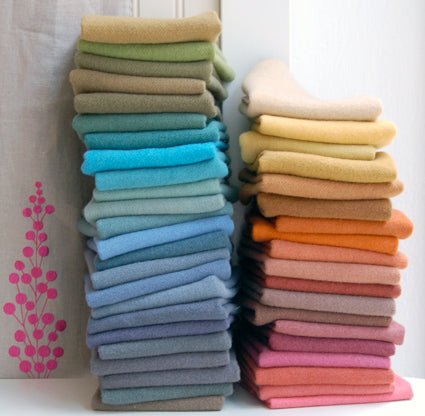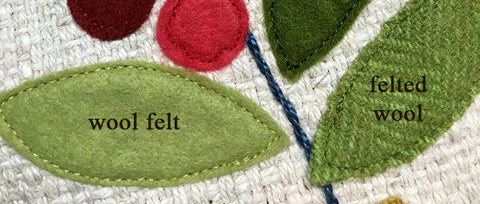Working with wool . . . .

Working with felted wool or wool felt (yes, there's a difference) is easy and addictive. Felted wool doesn't fray, so you don't need to turn under the applique edge.
There are different types of wool, which can be confusing.
I’ve experimented with three types and like them all for different reasons. In fact, I often combine them in one project.
Keep in mind that some projects are meant to be precious heirlooms, worthy of the expensive stuff, while some projects are just for fun. I frequently use pricey felted wool for the main body of a project with budget-friendly felt for the applique. Not just to save money, but because I love the clean applique edge you get with felt.
If you're not sure which kind to use, buy a little of each and play around. I love and use them all. Happy stitching!
~ Teri Christopherson
FELTED WOOL:
-
Woven wool fabric that's been felted (shrunk), like the sweater you accidentally threw in the dryer.
-
This is the good stuff, the expensive stuff, the luxurious stuff. There's no matching it's lovely texture and drape.
-
Make your own by throwing wool fabric in the washer and dryer. It's that easy. But be warned, your house will smell like a wet dog.
-
You can buy it in many gorgeous colors, often over-dyed for a variegated look.
-
Thicknesses and weaves vary. Smooth, nubby, thin, thick, solid, plaid, or herringbone, whatever appeals to you.
-
For applique, it gives a rustic, imperfect edge (like the bee below).
-
I use it when I want the project to drape nicely (not be stiff), or I want the applique to have a textured, natural look (like the bee), or I want a high-end result.


Now, let's talk about FELT (pictured below). Felt is made of bonded fibers and has a flat, consistent thickness, which makes it easy to work with. Zero fraying. Inexpensive, so you can stock up on colors--and it comes in a hundred.
I've worked with two types of wool felt: wool blends (usually wool/rayon) and 100% wool felt. I'll explain the differences below.
Note: this is not the synthetic felt you find in most craft stores. Save that for the kiddie projects. Wool felt is sold at some quilt stores, higher-end craft stores, and online.

From my experience, the wool-blend felts are better at draping and not stretching but look and feel a little "fake", while the 100% wool felts have a richer look and feel but are a little stiffer and stretchier.
WOOL-BLEND FELT (usually wool/rayon):
-
Made of bonded wool/rayon fibers. The rayon adds pliability (drape).
-
Consistent thickness, smooth finish, zero fraying.
-
Very inexpensive, so you can stock up on colors.
-
Gives a perfect applique edge. I love it for applique.
-
Looks and feels a little "fake", which isn't noticeable on small or medium pieces.
-
Doesn't drape as nicely as felted wool, but drapes well enough--and drape doesn't matter on some projects.
-
More pliable (less stiff) than 100% wool felt (from my experience).
-
No stretching.
100% WOOL FELT:
-
Made by bonding 100% wool fibers.
-
Consistent thickness, smooth finish, zero fraying.
-
Low price, so you can stock up on colors.
-
Gives a perfect applique edge. I love it for applique.
-
Looks and feels better than the blends. Rich color and buttery soft.
-
A little stiffer and stretchier than the blends, which only matters on some projects. (The fuchsia flap on the tech cover below is 100% wool felt, so it doesn't fold as softly as the navy felted wool).
-
I love it for applique (like the fuchsia butterfly below), not in projects where its stiff drape or slight stretchiness will be a problem.
Notice the wonderful earthy texture of the navy FELTED WOOL below. Definitely worth the high price for some projects. The blossom appliques are less expensive WOOL BLENDS. Notice the clean edge you get with blends, which is nice for small detail work, like the top row of leaves.
.
Compare pliability by looking at the flaps on these tech covers. Above, the navy FELTED WOOL is the most pliable (softest drape). Below, the gray BLEND is a little stiffer (but not bad), and the fuchsia 100% WOOL FELT is stiffest of all (but still works).
The fuchsia butterfly is 100% WOOL FELT. Notice the clean applique edge and rich color. Wool felt has a richer, woolier look and feel than the blends.
Don't be afraid to mix it up, like my Sing Your Song project below. The navy background is 100% WOOL FELT, the gray flap and blue words are BLENDS, and the bird is FABRIC.


SEWING WOOL APPLIQUE
You don’t have to turn under the edges! For those who want to keep it quick and simple, use a machine stitch. For those who love a little handiwork (like me), use a hand stitch.
Machine Stitch:
- Sew just inside the applique edge with a thread color that matches (regular sewing thread).
- Tight curves can be tricky, as shown on the red berry below. Use a short stitch and go slowly.
- For WOOL FELT (lighter green leaf below), this machine stitch looks great.
- For FELTED WOOL (medium green leaf), it can look messy. I prefer a hand stitch.

Hand Stitch:
- Use a tiny 1/16” whip stitch with 2 strands embroidery floss (inexpensive) or wool thread (nice but pricey), in the same color as the applique. Do not use regular-weight thread, which is too thin.
- I use a chenille needle, about size 22 or 24.
- Knot your thread. Bring needle from back of project 1/16” inside the applique edge. Put needle back down just outside the applique edge, creating a straight stitch. On tiny pieces, use smaller stitches.
- WOOL Felt -- it works great. (lighter green leaf below).
- FELTED WOOL -- it works great. (darker green leaf and gold star below).
- It's easy and relaxing and looks wonderful.

Buy some wool and have fun with it! You'll soon be addicted.
~ Teri Christopherson
